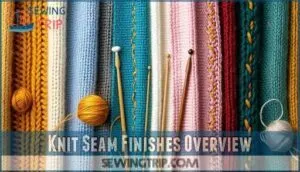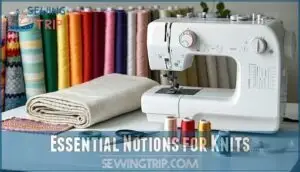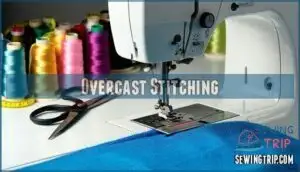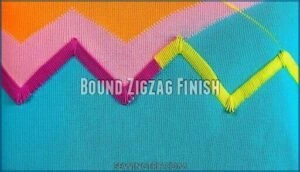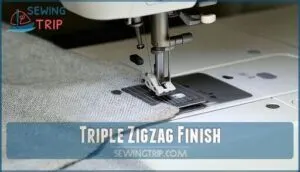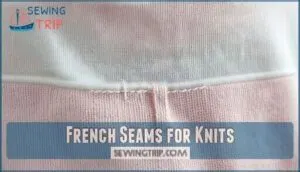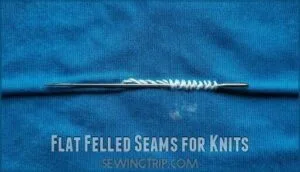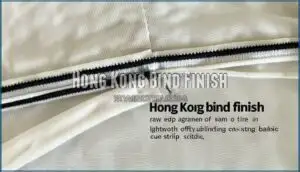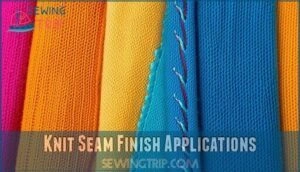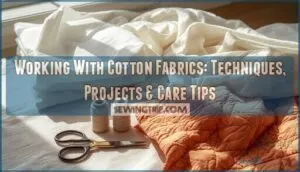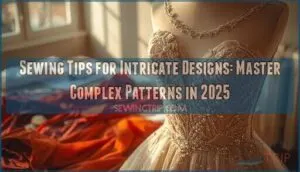This site is supported by our readers. We may earn a commission, at no cost to you, if you purchase through links.
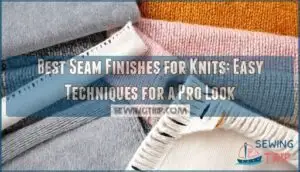 For knits, you’ll want seam finishes that maintain stretch while preventing fraying.
For knits, you’ll want seam finishes that maintain stretch while preventing fraying.
The zigzag stitch is your workhorse—quick and effective on most knit fabrics.
Serged edges create professional results if you have the equipment.
Don’t have a serger? Try the mock overlock stitch on your regular machine.
For lightweight knits, simply trimming edges works fine, while medium-weight fabrics benefit from a double-stitched seam.
Pressing seams open with a low-heat iron helps them lay flat.
Remember that different knit types need different approaches—what works for cotton jersey might not suit ponte or sweater knits.
The right technique can transform your homemade project into a polished garment.
Table Of Contents
Key Takeaways
- Use zigzag stitches or stretch stitches to maintain elasticity while preventing fraying on knit fabrics.
- Choose seam finishes based on fabric weight—lightweight knits benefit from simple trims, while heavier knits need serging or double-stitched seams.
- Pair the right tools, like ballpoint or stretch needles, with techniques like mock overlock or twin needle hems for polished results.
- Stabilize tricky areas like necklines or armholes with fusible tape or clear elastic to prevent distortion and maintain durability.
Knit Seam Finishes Overview
In the context of finishing seams on knits, choosing the right technique can make a big difference in your project’s durability and look.
From simple zig-zag stitches to more advanced finishes, there are options to suit every fabric and skill level.
Zig-zag Finish for Knits
The zig-zag finish is a beginner’s ally for clean, stretchy knit fabric seams.
Adjust your sewing machine stitches for knits by fine-tuning these essentials:
- Zig-zag width: Start narrow, around 2.5 mm wide.
- Stitch length: Set to 2-3 mm for smoother seams.
- Tension settings: Reduce if puckering occurs.
It’s quick, durable, and perfect for stable knits.
For enhanced durability and a professional look, consider how seam finishing prevents fraying.
Stretch Stitch Finish
When working with knit fabrics, the stretch stitch finish offers superior stitch elasticity that moves with your fabric.
Your sewing machine’s built-in stretch stitch creates a durable, flexible seam that won’t pop when stretched.
Adjust tension settings slightly looser than normal and pair with the right needle choice (ballpoint or stretch) for best results.
This technique works beautifully on t-shirts, activewear, and other knit seams that need to flex.
Fake Overlock Finish
If you don’t have a serger, fake overlock is a great choice for knit seam finishes.
It looks like true overlock knit seams but uses your sewing machine.
Adjust these settings for smooth results:
- Presser Foot Choice: Opt for an overedge foot.
- Tension Adjustments: Fine-tune to prevent puckering.
- Stitch Width Options: Experiment for clean edges.
Essential Notions for Knits
You’ll need the right tools to tackle knit fabrics with confidence and achieve professional results.
From Heat&Bond Soft Stretch for stable hems to chrome ballpoint needles that won’t snag your fabric, these essential notions will make your knit sewing projects much easier.
Heat&Bond Soft Stretch
After working with various knit finishes, you’ll find Heat&Bond Soft Stretch is a game-changer for your projects.
This specialized fusible interfacing provides knit stabilization while maintaining fabric stretch. Apply it to seam allowances to prevent distortion and create crisp edges.
Unlike regular interfacings, it washes beautifully without stiffening your garment. For best results, use a pressing cloth and test on scraps first.
Using it with the right needles and threads is also essential for preventing damage, and following these steps will help you achieve a professional finish with minimal effort and great results.
Chrome Ballpoint Needles
The right needle can make or break your knit sewing projects.
Chrome ballpoint needles are essential for professional-looking knit seams without fabric damage.
You can find various needle products online.
- Size 70/10 for lightweight jerseys
- Size 80/12 for medium-weight interlock knits
- Size 90/14 for heavier sweater knits
- Schmetz and Organ are reliable needle brands
- Replace after 8-10 hours of sewing for best stitch quality
Twin Needles for Knits
Twin needles offer your knits a professional hem finish that mimics coverstitch machines.
When working with knits, choose a 2.5-3mm spacing and proper tension settings to prevent fabric tunneling. Install two spools on your sewing machine, threading both through separate tension discs.
Remember to use ballpoint twin needles for fabric stability. For best results, slightly stretch the fabric while sewing to avoid troubleshooting loops later.
They’re perfect for decorative stitching too! Many sewers find success with specialized twin needle products.
Knit Seam Finishing Techniques
You’ll find several effective ways to finish seams on knit fabrics that prevent fraying while maintaining stretch.
From overcast stitching to bound zigzag and triple zigzag finishes, these techniques will give your handmade knit garments a clean, professional appearance that lasts through wear and washing.
Overcast Stitching
Now that you’ve got your essential notions ready, let’s look at overcast stitching—the bread and butter of knit seam finishes. Your sewing machine likely has built-in overcast stitches that mimic serger knit seams without the extra equipment.
Many sewers find a specialized overcast machine helpful for this task.
- Set stitch width to 3-4mm for ideal fabric stability
- Adjust tension settings slightly looser than normal
- Choose the right needle type (ballpoint for most knits)
- Practice on scraps before working on your actual project
Bound Zigzag Finish
While overcast stitching works well for many knits, the bound zigzag finish offers both functionality and flair.
This technique combines a zigzag stitch with binding tape along the seam edge. You’ll need to match your fabric choice with appropriate binding width and adjust your stitch settings for best results.
With proper tension adjustments, this finish prevents stretching while creating decorative options for your knit seams. It’s particularly effective for stabilizing stretchy fabrics that might otherwise wave or curl, making it a great option for those looking for a functional and flair finish.
Triple Zigzag Finish
The triple zigzag finish offers three powerful rows of stitching that prevent knit fabrics from stretching out of shape.
You’ll want to adjust your stitch length to medium and maintain proper tension settings for best results.
This technique works exceptionally well on medium-weight knit fabrics where stability is essential.
Try it on necklines or armholes where regular zig zag stitch mightn’t provide enough strength for your sewing seams.
For a professional look, remember that seam finishing is key to durable garments.
Advanced Knit Seam Finishes
You’ll take your knit sewing to the next level with these advanced finishing techniques that prevent stretching and fraying while creating professional results.
These methods, including French seams, flat felled seams, and Hong Kong binding, will help your handmade knit garments look store-bought rather than homemade.
French Seams for Knits
Many sewists are surprised to learn that French seams can work beautifully on knits, especially for lightweight or sheer knits where exposed edges might detract from your garment.
Here’s a short, engaging blockquote in the same tone as the paragraph:
French seams on knits? Absolutely! They’re the secret weapon for those delicate, sheer projects where clean edges matter.
Though traditionally reserved for wovens, French seams create a clean, enclosed finish that’s perfect for sensory-friendly garments.
Start with wrong sides together, stitch at 3/8", trim allowance, then fold right sides together and stitch again at 1/4".
Flat Felled Seams for Knits
In spite of common misconceptions, flat felled seams work beautifully on knit fabrics when you adapt the technique properly.
These durable finishes add structure while maintaining stretch for active wear pieces.
- Use a longer stitch length (3.0-3.5mm) with stretch thread to preserve fabric elasticity
- Choose chrome ballpoint needles specifically designed for knits to prevent snags
- Apply gentle pressing techniques with steam to set stitches without distortion
Hong Kong Bind Finish
While flat felled seams offer durability, the Hong Kong bind finish brings elegance to your knit projects.
This technique wraps raw edges in bias strips, creating a clean interior that won’t fray.
For best results, choose lightweight bias strips that complement your knit fabric, and securing ends properly prevents unraveling.
While careful curve application guarantees smooth binding even on stretchy edges, this finish is ideal for unlined knit garments, providing a professional look.
Thread selection should match your fabric’s stretch capacity to ensure a lasting and visually appealing finish.
Knit Seam Finish Applications
You’ll need to match the right seam finish to your specific knit fabric to get professional results.
Lightweight knits work well with zigzag finishes, while bulkier knits benefit from flat-felled or bound techniques that prevent unwanted stretching and provide durability.
Seam Finishes for Marl Knit
While Hong Kong and flat felled finishes are excellent for structured fabrics, marl knit fabrics need special handling.
Four top options work wonders for these textured knits: overlock finish with stretchy Maraflex thread, French seams with zigzag edges, stretchy Hong Kong finish, and catch stitching to hold down seam allowances.
When selecting your approach, consider your fabric type, machine settings, and whether preventing curling is a priority.
A wiggle stitch on thicker knit seams adds flexibility while maintaining strength, and is a key consideration for textured knits.
Finishing Seams for Bulky Knits
When working with bulky knits, your tension adjustment becomes vital for preventing edge curling and ensuring professional results.
Tackle thickness challenges with these techniques:
- Hand overcast stitching provides flexibility and minimizes bulk in your knit seams
- Layer management through strategic trimming keeps bulky seam allowances manageable
- Binding with stabilizers like Heat&Bond Soft Stretch prevents distortion while maintaining stretch
Press seams open using a pressing cloth to reduce bulk without flattening your fabric’s texture, and ensure that your work looks professional with professional results.
Choosing Right Seam Finish
Now that you’ve mastered handling bulky knits, let’s talk about selecting the perfect seam finish for your project.
When choosing a seam finish for knit fabrics, keep the following five key factors in mind:
| Factor | What to Consider |
|---|---|
| Fabric Type | Stretchy vs. stable knits require different techniques |
| Garment Use | Athletic wear needs stronger finishes than casual tops |
| Skill Level | Some techniques are beginner-friendly, others advanced |
| Time Commitment | Quick finishes vs. more polished, time-intensive options |
| Aesthetic Preference | Visible decorative finishes vs. hidden, clean looks |
The key to a successful project is considering these factors to ensure a professional finish that meets your needs, whether it’s for athletic wear or casual clothing.
Frequently Asked Questions (FAQs)
Which type of seam finish is used on knits?
For knits, you can use seam finishes like zig-zag stitch, stretch stitch, or fake overlock.
These methods let the fabric stretch naturally while keeping edges neat.
A serger adds extra polish if available, which can be considered a key step to enhance the polish of the fabric.
What is the best seam for knitting?
In the context of knitting projects, choosing stretch stitches is a game-changer.
Opt for a zig-zag or a stretch stitch—they move with the fabric, preventing puckering and creating smooth, durable seams every time.
What is the best seam for stretchy fabric?
Stretchy fabrics need seam finishes that move with the material.
Use a stretch stitch for durability or a zig-zag for flexibility.
If you’ve got a serger, it’s perfect for professional-looking, stretchy seams.
What hems are best for knits?
For knits, use hems that stretch with the fabric.
Twin needle hems work great for a professional finish, while zig-zag or stretch stitches are quick options.
Experiment to find the balance between stretch and style!
Which seam finishes prevent knit fabric curling?
To stop knit fabric from curling, use seam finishes like zigzag stitch, overlock stitch, or a twin needle hem.
Press seams with steam, and stabilize edges with fusible tape or stay stitching for cleaner results.
Can coverstitch machines replace other knit finishes?
Coverstitch machines can’t fully replace other knit finishes but excel at hemming, providing stretchy, professional hems.
For seams, pair it with serging or zig-zag stitching to prevent fraying and curling, ensuring durability and flexibility.
Are clear elastic seam stabilizers recommended?
Clear elastic seam stabilizers are a great choice for knits.
They provide support, prevent stretching, and help seams hold their shape.
Use them on shoulder seams, necklines, or areas prone to distortion for durability.
Do different knit weights require different finishes?
Think of knits like a collection of personalities—each weight needs a customized finish.
Lightweight knits love stretch stitches or zigzag, while heavier ones prefer serged edges or flat seams for durability and a clean look, which can include serged edges.
How to finish armholes on sleeveless knits?
Finish sleeveless knit armholes with a bound or fold-over elastic.
Use a zigzag or stretch stitch for durability.
Press well to guarantee neatness, and always test stitch settings on fabric scraps first.
Conclusion
Mastering the best seam finishes for knits can elevate your sewing projects from homemade to professional.
By choosing techniques like zigzag stitching, mock overlock, or bound edges, you’ll maintain the fabric’s stretch while preventing fraying.
Each knit fabric—from lightweight jersey to bulky sweater knits—calls for a customized approach.
With the right tools and methods, like stretch needles and low-heat pressing, your seams will look polished and last longer.
Practice and experiment to find what works best for your creations!
- http://www2.ca.uky.edu/agcomm/pubs/fcs2/fcs2304/fcs2304.pdf
- https://www.threadsmagazine.com/project-guides/learn-to-sew/keep-these-seam-finishes-in-your-bag-of-tricks
- https://www.doinaalexei.com/sewing-a-self-bound-seam-finish.html
- https://www.joann.com/heatnbond-soft-stretch-ultra-iron-on-adhesive-tape-5%2F8inx10yds/15389422.html?gclid=CjwKCAiA0JKfBhBIEiwAPhZXD8pUgEF2qCuI12YB0dujaQg6VZwpLan6CQjI6ImqO_Sgjxha__VNgRoCsRQQAvD_BwE

